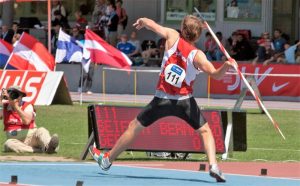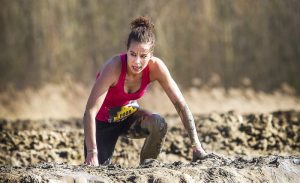Javelin throw
Javelin throwing is an athletics event in which a javelin is thrown, which is made of regulatory materials such as metal or fiberglass. The main objective of javelin throwing is to throw it as far as possible. This technique dates back thousands of years, when in ancient times, the javelin was used as an instrument of hunting and fishing, was an instrument of survival. Javelin throwing as a sport was first carried out in ancient Greece, during the pentathlon and the ancient Olympic Games.
What is javelin throw?
Javelin throw is an athletic technique in which the athlete must throw the javelin as far as possible. It is a technique that dates back to ancient Greece, where it was used for fishing and hunting for the survival of the people.
About javelin throw
The sport consists of the player taking position in a specific area and throwing the javelin without moving from the place where it is located. The greater the distance the player can throw the javelin, the better his score will be when it comes to competition.
History of javelin throw
In ancient times, the javelin was an instrument of war and an artifact that was used for survival since it was used as a method for hunting and fishing. It was the size of a hunter, thin and with a sharp point, which became round during competitions. There are indications of paintings and archaeological discoveries dating from the Chinese people around 4000 BC, was used by Egyptians as well. It was formerly called spear.
Technique
It is one of the most difficult athletics techniques, with an acceleration and deceleration technique that is transmitted to the javelin through the arm. Three different grip techniques are important:
- Forefinger and thumb grip: the thrower must embrace the javelin with these two fingers, encircling it up to the grip and then wrapping it with the whole hand. It is known as an American grip.
- The grip with the middle finger and thumb: in this technique the athlete must take the javelin with these fingers leaving the index finger below the javelin. It is known as Finnish grip.
- Pincer or orthopedic grip: take the javelin with the index and ring fingers and wrap the javelin with the whole hand. It is known as a fork.
Javelin throw rules
- The order of the competitors will be randomly drawn.
- If there are more than eight players, they may make three attempts each with three additional throws.
- If there is a tie in eighth place, competitors must make three more throws.
- Players may make two practice throws.
- Once the competition starts the players cannot use the impulse zone.
- Each competitor will be credited with the best of their throws.
- The use of hand bandages is not allowed unless the player has an injury.
- The player may wear a girdle to avoid damage to the spine.
- The javelin must be taken by the handle and thrown over the shoulder. Orthodox styles are not allowed.
- The throw will be invalidated if the tip of the javelin’s metal sheath fails to touch ground before any other part of it.
- The player must not cross parallel lines.
- If the player touches the drawn lines with his body, he will be disqualified.
- The player may not leave the impulse zone until the javelin touches ground.
- An incorrect throw-in will be considered a rehearsal, but null.
Javelin throw phases
The stages of javelin throw are as follows:
- Initial position: this is the phase in which the javelin is held by its gravity center or handle, then with the palm of the hand facing up, the fist is tightly closed to better hold the javelin. It should be observed in front, place the trunk upright and place the javelin at the height of the head. The arm with the javelin should be open and flexed at the elbow.
- Race: the objective is to reach the highest speed for more power. The race must be carried out progressively until reaching the throwing area.
- Final steps: there are five different steps in this phase. The first step, after placing the left leg, is to advance the legs to the trunk at the same time as carrying the arm that holds the javelin back. The second step is done with the right leg carrying the javelin back placing the tip level with our face. The third step is done with the outer edges of the heel, the javelin will continue going backwards, the shoulders should make a 90-degree turn to the right pointing to the throwing area and aligning the javelin with the shoulders. The fourth step is the driving step in which the right leg crosses to the left above the knee, the step should be wide but firm. The fifth step consists of the hips and legs forward arcing the trunk backward, at which point the hips push the trunk up and forward.
- Recovery: after the javelin is thrown, the body must maintain the forward movement to cushion the impulse by bending the knees and hips to avoid disrespecting the rules.
Track
The track is marked by two parallel lines separated 4 meters from each other. The launch line is 7 cm wide. The center of this corridor is located between the track mark lines. From this main point, two lines extend beyond the launch line to reach a distance of 90 meters. All pitches must fall between these two lines.
The area
The launch pad area should be between 32 meters and 36.5 meters long and about 4 meters wide. The arch or front limit of the race track must be a curved line painted in white, can be wood or metal, or can be painted directly on the ground. Sectoral lines start at 8 meters from an inside point of the arch and extend to marking flags at an angle of 29º.
Shoes
Nail slippers must be used, which have different holes in their soles, approximately between four and seven, in which special nails are screwed to the sole. These nails are placed with the objective of providing protection and greater stability to the feet when they adhere to the floor. The most common are pyramidal, compression and needle nails.
How to cite this article?
Briceño V., Gabriela. (2019). Javelin throw. Recovered on 4 January, 2025, de Euston96: https://www.euston96.com/en/javelin-throw/










